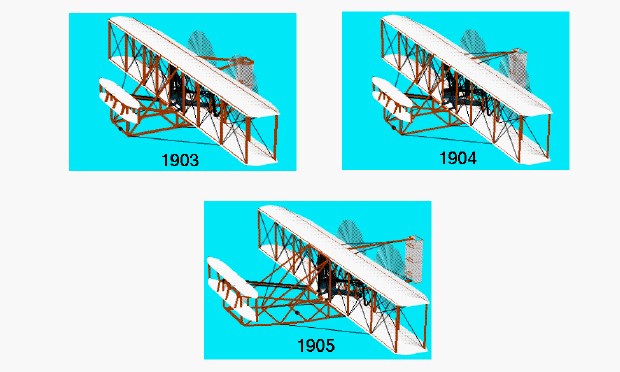Powered Aircraft (1903 – 1905)
In 2003, the world celebrated the 100th anniversary of the first flight of an airplane by the Wright brothers at Kitty Hawk, North Carolina. While much attention was paid to the events of December 17,1903, it is important to note that the four flights of that day were only one small step in the development of the airplane. The brothers had already invested three years of work between 1900 and 1902 perfecting unpowered gliders and learning to fly. It would take another three years work, from 1903 to 1905, until all the problems of their powered airplane were solved. On this page, we show scaled computer drawings of the powered aircraft which were built and flown by the Wright brothers between 1903 and 1905. You can compare the performance of these aircraft by using an interactive performance prediction program on another page.
Between 1903 and 1905, the brothers built a series of aircraft which would eventually lead to the first practical airplane. Based on the success of their 1902 glider, the brothers decided to build a larger, powered version of the aircraft upon their return to Dayton in late 1902. The brothers made inquiries with many automobile manufacturers to procure an engine which would meet their requirements for both light weight (less than 200 pounds) and moderate horsepower (8-10 horsepower). When all the replies came back negative, they built their own 4 cylinder, 12 horsepower, internal combustion engine in a period of just six weeks. They also designed and built highly efficient aircraft propellers using their wind tunnel results and realizing that they must be shaped as a rotating airfoil.
In September of 1903, they returned to Kitty Hawk with their new aircraft. The aircraft was similar to the 1902 craft with twin wings, twin rudders, and canard elevators. The wing span was now 40 feet long, with a six foot chord and six feet between the wings. The plane also carried twin counter-rotating pusher propellers connected by bicycle chains to the 12 horsepower motor. The pilot would lie beside the motor on the lower wing. With the pilot and the motor, the new aircraft weighed about 750 pounds. After a number of frustrating problems with the propeller shafts and transmission sprockets, they finally made four successful flights on December 17, ranging from a little over 100 feet to over 800 feet. Each of the flights was marked by an instability in pitch: the nose, and consequently the entire aircraft, would slowly bounce up and down. On the last flight, hard contact with the ground broke the front elevator support. A strong gust of wind caught the plane while it was on the ground, picking it up and rolling it across the sand. The damage was too great to repair, so the brothers packed up and returned to Dayton.
The brothers immediately began work on a new 1904 aircraft. They built a new engine similar to the 1903 engine but they increased the power to 18 horse power by slightly increasing the bore (diameter of the piston) of the engine. They also built a new airframe which was very similar to the 1903 aircraft in size but with redesigned rudders. The new aircraft was flown from a cow pasture owned by Torrence Huffman and located just outside Dayton. Without the winds of Kitty Hawk, it was a problem getting enough airspeed to fly. So the brothers devised a catapult system to help launch the aircraft. Once airborne, the aircraft experienced the same pitch problems as the 1903 aircraft. In an effort to solve the problem, they moved radiator and fuel tank from the front struts to the rear struts and moved the engine slightly aft to move the aircraft center of gravity aft. But this only made the pitch problem worse. So the brothers added 70 pounds of iron bar ballast to the front elevator to move the center of gravity farther forward. The weight of the aircraft then increased to about 900 pounds with the pilot. The ballast improved the handling of the aircraft and Wilbur was able to complete the first circuit of the airfield on September 20, 1904. By the end of the year, the plane could complete four circuits and stay in the air for five minutes, but the aircraft still had major handling problems and was overweight.
The brothers were finally able to solve the pitch problem by increasing the size of the elevator and rudder and moving the elevator and rudder farther from the center of gravity on the new 1905 aircraft. This increased the torque produced by the control surface and provided greater control for the aircraft. The overall length of the aircraft increased from 18 feet to 28 feet. The radiator and fuel tank were moved back to the front strut and the size of the fuel tank was increased. The engine stayed the same as the 1904 aircraft and the ballast was discarded, reducing the weight to 850 pounds with pilot. The 1905 aircraft could be flown until the fuel tank was empty; staying in the air for more than a half hour, flying nearly 25 miles around Huffman’s farm, executing turns and figure 8’s, and flying more than 50 feet off the ground. After six years of work, the brothers finally had a practical working airplane and began to market it to the War Department.

